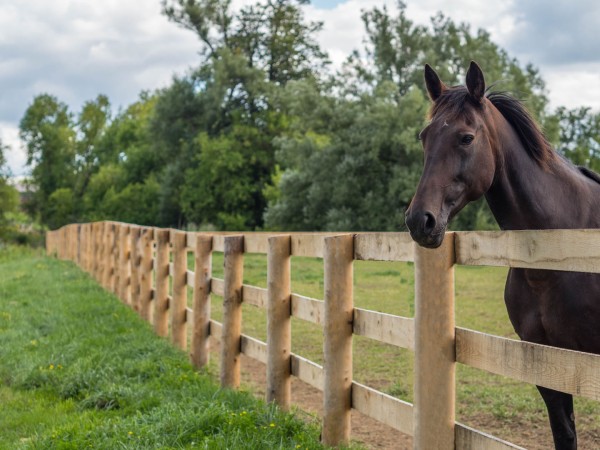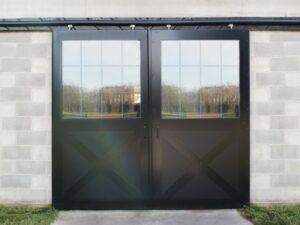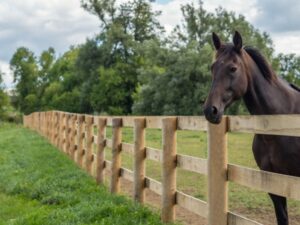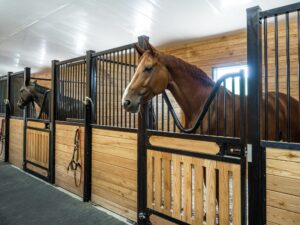In the world of equestrian care, few things are as crucial yet frequently overlooked as the integrity of our fencing.
Picture this: the tranquillity of a serene morning disrupted by the sight of a damaged fence – a silent alarm signalling potential peril for our cherished equine companions.
This scenario underscores the importance of repairing damaged horse fences, not just as a routine maintenance task, but as a critical element of horse safety and farm management.
Welcome to our comprehensive guide to repairing damaged horse fences. Below, we’ll explore the common fencing issues and cover some easy repair steps for a quick DIY fix.
Common Fence Problems and Solutions
When it comes to horse fences, there are a variety of common problems that can arise. It is crucial to address these issues promptly to ensure the safety of your horses and maintain the integrity of the fence.
Here are some of the most frequent fence problems and their respective solutions:
1. Knocked Down Sections
Strong winds, fallen tree branches, or even mischievous horses can knock down sections of the fence.
To fix this problem, start by removing any debris or obstructions from the area. Then, reattach the fence sections using suitable tools and materials.
Be sure to inspect the remaining fence for further damage and make any necessary repairs.
2. Loose Staples
Over time, staples that secure the fence wires to the posts can become loose, compromising the fence’s stability.
Check the fence regularly for loose staples and use a hammer or staple gun to pound them back in securely. This will help maintain the tension of the fence and prevent sagging.
3. Broken Wires
Broken wires are a common issue in horse fences, especially if the fence is old or has endured external pressure.
To repair broken wires, splice them together using sturdy wire connectors or specialized fence repair tools. This will restore the continuity of the fence and ensure horses cannot escape or injure themselves.
4. Damaged Insulators in Electric Fences
Electric fences rely on insulators to keep the wires in place and provide a safe containment system. If the insulators become damaged, the electric charge may be compromised, rendering the fence ineffective.
Inspect the insulators regularly and replace any that are cracked or broken. This will ensure the electric fence functions properly and serves as an effective deterrent for horses.
By promptly addressing these common fence problems, you can maintain a safe and secure environment for your horses.
Fence Inspection Checklist
Regular inspection is a crucial part of maintaining the safety and integrity of your horse fence.
By following this fence inspection checklist, you can identify and address any potential issues promptly. Remember, ensuring the safety of your horses is paramount.
Wood Fencing Inspection
- Check each post for stability. Push on them to ensure they are firmly planted in the ground.
- Look for signs of rot or decay on the wood. Pay attention to areas near the ground, as they are prone to moisture damage.
- Inspect the boards for any signs of damage, such as chew marks or splintering.
- Assess the overall condition of the fence and determine if repainting or staining is needed.
PVC Fencing Inspection
- Check for any cleanliness issues, including dirt accumulation or mold growth.
- Inspect the PVC panels for any cracks, breaks, or other damage.
- Ensure that all connectors and brackets are securely fastened.
Electric Fencing Inspection
- Inspect the insulators for any signs of damage or wear.
- Check for any foliage overgrowth that might cause the fence to ground out.
- Check the tension of the wires to prevent them from becoming loose or stretched.
- Test the voltage of the electric fence to ensure it is functioning properly.
Pasture Inspection
- Inspect all gates to ensure they are properly aligned and functioning correctly.
- Look for any leaning or sagging sections of the fence and address them promptly.
- Remove any fallen branches, debris, or problematic plants from the pasture area.
Regular fence inspections and maintenance are essential to ensure the safety and security of your horses. By following this checklist, you can identify and address any issues in a timely manner, preventing accidents and maintaining a secure environment for your horses.
Different Types of Horse Fencing
Whether you’re looking to upgrade damaged fencing or are preparing to create a new pasture, choosing a horse fence that successfully serves its intended purposes enhances the overall safety and well-being of horses.
It provides peace of mind for owners, knowing that their horses are securely contained and protected. A well-designed fence gives horses the freedom to exercise, graze, and interact with their surroundings while minimizing the risk of accidents and injuries.
Post and Rail Fences
Post and rail fences are a popular choice for horse owners looking for an attractive, visible, and safe fencing option. These fences are commonly made from various materials, such as treated or painted wooden planks, split rails, or PVC plastic boards.
The versatility in materials allows horse owners to select a fence that suits their preferences and requirements.
Pros of Rail Fences
- Classic countryside look.
- High visibility to reduce accidents
- Easy installation
- Long-lasting with quality materials.
Cons of Post and Rail Fences:
- Susceptible to rot/weathering.
- Higher upfront cost for quality materials.
- Needed to ensure safety
- Not ideal for all terrain types.
 Flex Fencing
Flex Fencing
Flex fencing, a style that has rapidly gained acclaim for its unique blend of safety, durability, and aesthetic appeal.
Designed to withstand the rigorous demands of horse farms, this type of fencing is characterized by its high-tensile wire core encased in a durable, flexible polymer.
This construction allows the fence to absorb impacts, significantly reducing the risk of injury to horses by flexing upon contact instead of breaking or splintering.
Its strength and resilience make it an ideal choice for property owners looking for a long-term fencing solution that ensures the well-being of their animals.
Beyond its safety features, Flex fencing also stands out for its maintenance-free design and visual attractiveness.
Available in various colours, it can seamlessly blend with or enhance the natural beauty of any landscape, contributing to the overall aesthetic of the property.
Pros of Flex Fencing:
- Unmatched durability with high tensile steel wire and bonded polymer.
- Flexes upon impact, significantly reducing injury risks.
- Low upkeep with high-quality, mildew-resistant materials.
- Offers a prestigious fence look with enhanced safety.
Cons of Flex Fencing:
- Higher upfront cost but offset by long-term savings.
- Requires more planning and effort than simpler fencing options.
Check out this quick video about our High Impact PLUS Flex Fencing to get an idea of why flex fencing is quickly becoming a go-to selection:
Mesh Wire Fences
Mesh wire fences are a popular choice when it comes to ensuring the safety and security of horses. These fences are known for their durability and ability to prevent hooves from getting caught.
One of the key advantages of mesh wire fences is their small openings, which eliminate the risk of sharp wire ends that can potentially harm horses.
Two common types of mesh wire fences suitable for horses are diamond mesh and square mesh.
These fences are not only cost-effective alternatives to rail fences, but they also provide high visibility to horses, minimizing the chances of accidental collisions.
When constructing mesh wire fences, the use of proper gauge wire and correct spacing is essential to ensure the overall strength and safety of the enclosure.
By selecting the appropriate materials and paying attention to construction details, you can create a secure and reliable fence for your horses.
Advantages of Mesh Wire Fences
- Safe and durable
- Prevents hooves from getting caught
- Eliminates the risk of sharp wire ends
- Less expensive than rail fences
- Highly visible to horses
Disadvantages of Mesh Wire Fences
- Requires proper gauge wire and correct spacing
- May not be as aesthetically pleasing as other fence options
Electric Fences
Electric fences offer an effective solution for containing horses, but ensuring their visibility is crucial for the safety of both the animals and their handlers.
While smooth coated wire fences are commonly used, it is important to enhance their visibility using specific materials that can be easily seen by horses.
In addition to permanent electric fencing solutions, temporary fencing options may be required for specific situations.
While aluminum wire, temporary tapes, and ropes may be suitable for temporary enclosures, it is important to note that they may lack the durability needed for long-term use.
Once horses have familiarized themselves with electric fences, they generally respect the boundaries and remain contained within the designated area. Electric fences, when properly designed and maintained, provide a reliable and efficient method for horse containment.
Pros of Electric Fencing
- Effective horse containment
- Enhanced visibility options available
- Long-term durability with proper maintenance
- Allows for long stretches of fencing
Cons of Electric Fence
- Requires maintenance and periodic checks
- Can be expensive to install
- Temporary fencing options may lack durability
- May require professional installation
Choosing the Right Fence
When it comes to selecting a horse fence, several factors should be considered to ensure the safety and security of your horses.
Consulting with experts or professionals in the field can provide invaluable guidance and insights.
They can assist in determining the most suitable fence materials and designs based on your specific requirements.
Whether you have a small pasture or a large equestrian facility, their expertise can help you make an informed decision.
Factors to Consider
Consider the following factors when selecting a horse fence:
- Cost: Consider your budget and the long-term costs associated with materials, installation, and maintenance.
- Durability: Choose materials that can withstand weather conditions and the wear and tear of horses.
- Visibility: Ensure the fence is highly visible to horses, reducing the risk of accidental collisions.
- Maintenance Requirements: Consider the level of maintenance required to keep the fence in optimal condition.
By carefully considering these factors, you can select a horse fence that meets your needs and provides a secure environment for your horses.
Horse Fencing Installation in Rockwood, ON
Repairing damaged horse fences is crucial for ensuring the safety and containment of your horses.
By implementing regular inspections, performing necessary repairs, and selecting the right fence for your needs, you can ensure the safety, containment, and well-being of your horses.
At System Equine, we provide a wide range of horse fencing solutions, ensuring everyone who walks through our doors finds exactly what they’ve been looking for.
With our professional fence installation, we can help you enhance your next pasture project, ensuring a quality installation, and giving you peace of mind knowing your equestrian companions remain safe in their fields.
Contact us or explore our horse fencing options online today.
